Overtaking
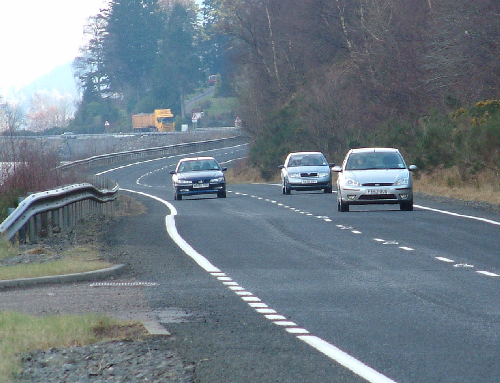 As explained in the introduction for this section, overtaking smashes may not be the most common type of accident on our roads they are certainly among the most serious.
As explained in the introduction for this section, overtaking smashes may not be the most common type of accident on our roads they are certainly among the most serious.
The overtaking method used by many drivers is flawed; that is why you should approach this section as if you were a novice, learning about overtaking for the first time.
A well planned and well executed overtaking manoeuvre is no more dangerous than any other manoeuvre. The important thing to remember is that you should avoid impulsive, opportunist overtakes.
The time to decide whether or not you want to overtake is when you first come up behind a vehicle, not when you see a gap. You may decide to overtake a vehicle and then follow it for miles before an opportunity arises.
The opportunity might not arise. Don't force it!
This session will teach you how you can use the MSPSG routine (hazard routine) to perfect your overtaking technique. The routine is important because you should never attempt an overtake if there is not enough time to consider each step carefully before acting.
You should be as relaxed about overtaking as you are about any other aspect of your driving.
Your practise sessions (overtaking) this week require a full understanding of the each of the topics explained on this page.
Location
 It's perhaps stating the obvious to say that before starting any overtaking manoeuvre you need to consider the safety of the location.
It's perhaps stating the obvious to say that before starting any overtaking manoeuvre you need to consider the safety of the location.
- Can you see clearly ahead?
- Are there any junctions to the left or right from
- where vehicles may emerge?
- Are there any gateways?
- How wide are the footpaths?
- Can you safely take advantage of, or rely on, cross-views?
You are looking for anything that might make your manoeuvre unsafe. For example, look at the picture above... Several drivers have died because they failed to see approaching cars in hidden dips
The obvious things are road features, markings and signs. Bends, hill crests, solid white lines, hatched areas, 'No Overtaking' signs, pedestrian crossings, etc. Defensive drivers will also be considering other information.
Remember reading the road? A 'cattle' warning sign, for example, might draw your attention to a greasy road surface which could cause danger when overtaking; skid marks might indicate a concealed entrance.
You should also aim to find a location that will minimise time spent on the wrong side of the road, often referred to a 'time exposed to danger'. With this in mind you could consider overtaking immediately after a junction or bend where the target vehicle's speed is slowest. If you do this, care must be taken not to surprise or upset the driver you are overtaking.
Overtake on the right except in the following situations:
-
Passing a vehicle that has signalled to turn right and you can overtake safely on the left (you must not enter a bus lane during its period of operation)
-
There are two lanes of slow-moving traffic and the lane to your right is moving more slowly than your own lane (do not change lanes to overtake in this situation)
-
You are in a one-way street and can pass safely on the left. You should only do this when using the correct lane for your destination
The wrong way!
 The driver in this photograph not only overtook a vehicle on a solid line, he started his manoeuvre before the brow of a hill, broke the speed limit (considerably!) and spent ages on the wrong side of the road because he didn't change down to accelerate ...
The driver in this photograph not only overtook a vehicle on a solid line, he started his manoeuvre before the brow of a hill, broke the speed limit (considerably!) and spent ages on the wrong side of the road because he didn't change down to accelerate ...
The vehicle he overtook (from which the photo was taken) was already driving at the maximum posted limit (60mph) and slowed to allow the overtaking car to pass safely.
This time the driver was lucky ...
Other drivers
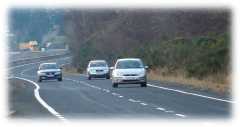 The fact that there is traffic approaching does not mean you cannot overtake.
The fact that there is traffic approaching does not mean you cannot overtake.
However you must be able to judge the speed of the 'closing gap' accurately. If the approaching vehicle is a heavy truck, it's unlikely to speed up. If on the other hand it's a sports car you may need to leave a greater margin for error.
To reduce the risk of giving approaching drivers a heart-attack (fear!), you must be able to judge the speed of the 'closing-gap' accurately. If two vehicles approaching each other at 45mph and 55mph respectively, the gap between them will be closing at approximately 48 metres per second.
Mini-project
As a 'mini-project' leave your computer for ten minutes, go outside and pace 45 metres – about 52 paces.
Now imagine covering that distance every second... That is your closing gap at modest main road speeds of around 50mph.
Now try pacing the same distance with your eyes tightly closed... How does it feel? My guess is that if you are able to do this you feel very vulnerable.
Well I've got news for you... That feeling of vulnerability is nowhere near your real vulnerability when overtaking dangerously! Even worse – many drivers don't even recognise that they are overtaking dangerously.
45mph, you + 55mph, approaching driver = a closing speed of 100mph. Around 45 metres per second!
In addition to approaching vehicles, you must also consider the vehicle that you are intending  to pass. Is it being driven erratically? Will it start to speed up? Who's driving? (Beware of cars with 'lucky-dice' dangling from the mirror – they are often driven by gamblers!)
to pass. Is it being driven erratically? Will it start to speed up? Who's driving? (Beware of cars with 'lucky-dice' dangling from the mirror – they are often driven by gamblers!)
As well as considering others when overtaking, you must also consider them when being overtaken. Let others overtake you if they wish to...
This doesn't mean that you must crawl around at a snail's pace letting everyone pass; it simply means that it is often safer to have someone in front, where you can see them, rather than behind.
There are no gold stars for being stubborn and blocking the path of other drivers. In the worst imaginable situation you could end up involved in someone else's accident. Remember, it's not a race. There are 100's of cars ahead and 1000's of cars behind, some will turn off the road, some will join it – no one is in front!
Deciding to go
Before starting any overtaking manoeuvre you must be 100% sure that you will be able to complete the manoeuvre safely. The combination of location and approaching traffic speed will help you to decide this.
If your car is not powerful enough to overtake using the method outlined in this course, it is not safe to overtake. Less powerful cars need much more space and time to overtake.
Here goes !!!
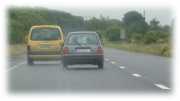 Many drivers give in to the temptation to to 'wind it up and swoop out' (the 'slingshot method'!).
Many drivers give in to the temptation to to 'wind it up and swoop out' (the 'slingshot method'!).
While this method will probably work, you are depending upon the actions of others to maintain your safety margins. If another driver makes a wrong move you will be left with no way out.
One of the targets you can set for yourself when considering an overtaking manoeuvre (see the project) could perhaps be:
"When overtaking I always maintain a safe distance from the vehicle ahead".
Of course – you must always consider what there is to gain by overtaking – as mentioned above for many it is just 20 or 30 seconds on their journey, for some it is life in a wheelchair or the death of a loved one. The decision to overtake could be the most important decision in your life. Close your eyes and count 30 seconds, an as you do this - think about it...
Understanding 'Hang-back'
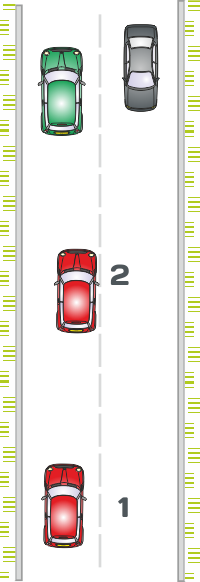 Note that this explanation is for driving on two-way roads. On dual-carriageways and other multi-lane roads the hang-back position is not needed as you can safely move out from a good distance behind the vehicle you intend to overtake.
Note that this explanation is for driving on two-way roads. On dual-carriageways and other multi-lane roads the hang-back position is not needed as you can safely move out from a good distance behind the vehicle you intend to overtake.
Hang-back is the name given to the road position that you should adopt prior to making your final commitment to overtake. This position will provide a good 'zone of vision' which will in turn assist your planning for the overtake.
The hang-back position (2) is substantially closer to the vehicle in front than a normal safe following position (1) - it will normally approximate to your thinking distance.
This position eliminates the need to close up a lot of space immediately prior to overtaking and enables the manoeuvre to be completed quicker and over a shorter distance. You must, however, compensate for the lack of separation distance by increasing your forward vision.
While 'hanging back', you may need to adjust your road position to the right or left in order to maximise forward vision, for example, if the road curves to the left ahead you may get a better view by moving to the left and looking beyond the 'target' to the nearside.
The hang-back position should not be adopted indefinitely. Driving in this position places increased stress levels on the drivers of both the overtaking vehicle and the target vehicle.
If an overtaking opportunity does not seem to be likely in the short term, a normal two-second following distance must be re-established.
Overtaking method
As with some earlier sections of the course, the notes on overtaking methods are based on the DriverActive advice for learners. This might seem odd for an advanced driving programme, but it is not as silly as it might at first seem – safe overtaking is safe overtaking, no matter what your level of experience...
In addition, many basic driving courses do not teach overtaking – the chances are that practical overtaking was not part of your initial driver education, especially if you are over 40 years of age.
In addition, experienced drivers are probably more likely to take risks by overtaking too fast in unsuitable locations or where they shouldn't be overtaking at all. Getting back to basics will help you to re-consider your overtaking method (if it's dangerous) or give you a safe system (if you have little experience of overtaking).
Read these notes and revise your knowledge on overtaking by reading any other resource material that you might have before going out to practise.
The first two considerations are:
- Do I really need to overtake?
- Is it safe to overtake?
The information below considers these questions and suggest a safe approach to overtaking.
Do I really need to overtake?
Always ask this question before starting any overtaking manoeuvre.
When following a long queue of traffic, or approaching a built up area, overtaking one or two vehicles is unlikely to affect your overall journey time, but will definitely increase your risk of an accident.
If you feel that overtaking is worthwhile, consider waiting for the right opportunity. If there is a dual carriageway ahead it will be better to wait until you get there before you overtake. If you are turning off soon it may not be worth overtaking.
Early to rise...
Professor Peter Russell, a key figure in UK driver training for many years, and a mentor in my early years in the business had a simple rule which reduces the need for overtaking – namely:
Good driving starts in bed!
Get up a bit earlier! This rule fits neatly with my own 'Ten minute rule' – allow an extra ten minutes journey time for every hour you expect to travel.
And of course - you must always consider what there is to gain by overtaking - for many it is just 20 or 30 seconds on their journey, for some it is life in a wheelchair or the death of a loved one.
The decision to overtake could be the most important decision in your life. Possibly the last decision...
Is it safe to overtake?
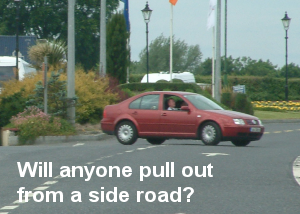 The obvious thing to look for is approaching traffic, but there are other considerations too.
The obvious thing to look for is approaching traffic, but there are other considerations too.
-
Is anyone overtaking you?
-
Are there any turnings or gateways that other vehicles may pull out from?
-
Is there a school or playground?
-
Are there any hidden dips
-
Will anyone pull out?
The bullets above list just a few of the potential danger points to consider before an overtake. Before you commit make sure that you can see far enough ahead and that you can allow a safe margin for error if something unexpected happens.
The overtaking plan
 The numbers (in brackets) correspond to the numbers shown on the diagram.
The numbers (in brackets) correspond to the numbers shown on the diagram.
Mirrors
Early repeated mirror checks are required to ensure that the road behind is safe and that you are not being overtaken yourself.
Hang-back
If the road appears to be clear ahead of the 'target' vehicle, close the gap to your 'launch point' selecting the most appropriate gear for brisk acceleration. Ensure that you position to maintain maximum forward vision. Never hold a position that is closer than a one second gap on a good, dry road.
Mirrors/Signals
Make a final check of all mirrors and consider a direction signal to show that you are moving out and/or a flashing headlamp signal to alert the driver ahead to your presence. Also check that the target vehicle, or other vehicles ahead, are not signalling to turn.
Position
Position: Move out with moderate acceleration (1). If the road is still clear increase power to drive through (2).
Mirrors/Position
(2) Ensuring that the 'target' car is clearly visible in the nearside mirror, start your gradual straight-line return to the left.
Mirrors
At (3) the overtaken vehicle should be clearly visible in your centre mirror and you should be pulling away to (4) opening the gap.
The red line shows how not to overtake!
Project 1
The first of three overtaking projects involves simply practising the routine.
On a stretch of dual-carriageway, practise using the method outlined in this section overtake as many cars as possible, moving back in to the left after completing each manoeuvre (as if on a two-way road).
By practising in this way, you can get used to the routines, speed and overtaking distances required without having to consider approaching vehicles.
Project 2
Go out for a couple of one hour sessions practising overtaking on an open 'A' class road. The object of your practice is to safely overtake as many vehicles as possible.
Note: It is important that you practice the method outlined in this course - if you have a low powered car, the opportunities to overtake will be fewer. During advanced driving tests you will only be expected to overtake where it is safe and appropriate to do so allowing for the vehicle that you are driving - crashing the car will not impress your examiner!
Project 3
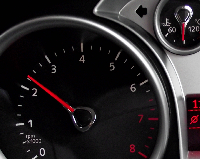 Because it is important to know how much power you have available in order to maximise safe overtaking opportunities this is a 'getting to know your car' exercise.
Because it is important to know how much power you have available in order to maximise safe overtaking opportunities this is a 'getting to know your car' exercise.
You simply have to find a safe location to drive your car up to its maximum speed in each gear (if you can do this without breaking the speed limit).
If you have a rev counter, take the needle to the start of the red line in each gear. Your handbook will give information about the maximum safe speed in each gear.